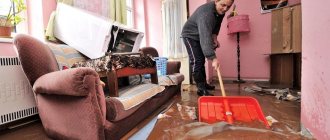Determine the source of apartment flooding:
By external signs in the form of wet spots on the ceiling and smudges on the wall, you can determine the source of flooding in the apartment. One of the common misconceptions is that an apartment can only be flooded by the neighbor above, but it is not uncommon for the source of the flood to be a side apartment or a fault in the building's utility lines.
Important:
When flooding the apartment, you must follow safety precautions and do not turn on electrical appliances. If possible, disconnect the apartment from power supply.
Recommendation: if possible, make video recordings (you can use a smartphone for these purposes) of flooded rooms, focusing on the details. Subsequently, the recording made may be useful for legal proceedings.
Eliminate the cause of flooding:
Prompt elimination of the cause of flooding will minimize the disastrous consequences of a utility accident. Let's assume that by looking at the wet spots on the ceiling you have identified the source of the flooding - your upstairs neighbors. If there are leaks only in the lower part of the wall, it makes sense to contact the owner of the adjacent premises. But it’s not always possible to quickly find the culprit neighbor, so let’s consider two situations:
2.1. The culprit neighbor was at home:
All the neighbor needs to do is turn off the tap.
However, if the cause of flooding is related to a violation of the integrity of common house communications (riser, radiator battery). In other words, the neighbor cannot influence the cause of the flood, then we follow the instructions in paragraph 2.2.
2.2. The culprit neighbor is missing:
The absence of a neighbor in the apartment is the most common situation. The peak of flooding occurs during the holiday period.
First of all, you need to call the neighbors who are responsible for the flooding, since sometimes before leaving on vacation, the keys to the apartment are given to one of the neighbors, or they are left with a contact phone number. If the search for keys/contacts is unsuccessful, then: you should report the incident to the UDS - the joint dispatch service or to another organization determined by the management organization.
The neighbors upstairs are flooding. What to do?
So, if your neighbors are flooded, what should you do? First you need to take safety measures - turn off the electricity. Property can always be purchased, and the main thing in this situation is to preserve life and health. Next, you need to take measures to record what happened - film traces of the flood on a photo or video camera. It is clear that if neighbors flood an apartment, the first reaction is the desire to eliminate the consequences of a domestic disaster as quickly as possible. But when it comes to recovering damages, evidence will be very useful to you.
If the neighbors flooded the apartment, it is not at all necessary that they are to blame. To determine the culprit, you should find out who owns the apartment, where exactly in the water supply system of the house there was a break and water leak. The riser may have broken. Then the culprit for the incident will be the housing department or the management company. The risers belong to the common property of all residents, who pay monthly fees for the maintenance of the property. Consequently, the housing department or management company should have taken timely measures to prevent the accident (replace, repair). If the responsibilities for maintaining the common property are not fulfilled, then compensation for losses (both to you and to your neighbors) falls on the specified structures.
Contact UDS:
UDS accepts citizens' requests in writing, orally and by telephone 24 hours a day. If you have a question about how to find an ODS phone number, you can find it:
- in a management agreement for an apartment building concluded between the owner and the operating organization,
— at the information stand near the elevator or at the entrance to the entrance,
- on the website of the management organization. The website of the management organization is indicated in the EPD (single payment document), and can also be found on the official website of Housing and Communal Services Reform: https://www.reformagkh.ru/.
If for objective reasons it was not possible to contact the UDS, then follow the requirements of paragraph 4.
Important:
After you have notified the ODS dispatcher about the incident, you need to find out his full name and registration data (number, time, date) of your request, as well as when a representative of the operating organization will be able to arrive to eliminate the cause of the flood and draw up a Report.
For reference: Each request is recorded in the requests log.
What needs to be done right away
Firstly, you need to initially inspect the apartment. If water flows down the walls and ceiling, the power supply must be stopped. This will protect residents from electric shock and more serious consequences. It's easy to do. There is an electrical panel on each landing. You need to find the lever in it that relates to the affected apartment and press it.
After this, turn off the water. Do not forget that the neighbors above may not know that they are drowning the lower living space. They simply may not be at home. The water is turned off in the basement.
According to the Civil Code of the Russian Federation, Article 290 and the Housing Code of the Russian Federation, Article 36, communication systems in an apartment building belong to the apartment owners by right of shared ownership. Only areas of responsibility are separated.
So there shouldn’t be any problems with cutting off the water supply.
The most important thing is to record the fact of flooding. This can be done using a camera or mobile device by filming what is happening on video.
Draw up the Bay Act:
Before we begin to consider the issue of the procedure for drawing up the Gulf Act, we should take into account various variations in the name of this document, for example:
— Damage act,
- Filling Act,
Act on flooding of premises (apartments),
Leak report,
and etc.
But all these different names imply the same document - the Gulf Act.
Regardless of the name of the document, the requirements for drawing up the Act are uniform!
The Bay Act requires the following to be specified:
— fix the flood (leak);
— establish and record the cause of the flood (if possible) or the source of the flood;
— record the amount of damage caused.
The person responsible for the spill must be notified in advance (3 days in advance) about the upcoming procedure - drawing up the Flood Report.
For reference:
The act acquires legal significance if it was drawn up in the presence of the injured and guilty parties, 2 independent persons (neighbors, chairman of the HOA, chairman of the council of the apartment building), a representative of the operating organization (chief engineer or other competent person).
During the process of drawing up the act, it is strongly recommended to make a video recording of the flooded premises and the group of people who signed the act, about which a corresponding note is made in the act.
Appendix 2 to the order of UGZ N 55-48/1 and UZHKhiB N 5-37/1 dated March 12, 2001 contains the requirements for drawing up the act.
Important:
The act is drawn up in any case. If, when drawing up the act, the person through whose fault the flood occurred, or a representative of the management organization, is absent, then the act must indicate the reason for the absence or the actions taken to notify the absent person.
How to prepare to go to court?
This can be a difficult and lengthy process, and if a verdict is entered in your favor, it does not mean immediate payment of the required amount. Regardless of the size of the amount, as well as the five-day period for execution of the court order. In reality, payments sometimes stretch out for a long time, sometimes for several months. This must be remembered when making such a decision to file a claim, since after this it will not be possible to begin repairs due to the possibility of re-examining the case.
First of all, at the preparatory stage it is necessary to call an independent expert so that he can assess the damage caused. To resolve this issue, contact the Chamber of Commerce and Industry or another serious organization of appraisers.
It is imperative that the entire process of interaction with the expert must take place officially: with the signing of an agreement, issuance of payment receipts, signing of an acceptance certificate for work performed, etc. Further, the amount of the expert’s services will be included in the single amount of damages.
The time and date of arrival of the expert must be told to the guilty party using a postal telegram, which is best sent 4-5 days before the scheduled date. If the guilty party does not arrive at the appointed time, this is noted in the act.
Inspection by an expert. When an expert inspects a damaged premises, it is worth pointing out to him the damage that you noticed yourself; also provide him with a flood report and, if available, documents (warranty card, receipt) for household appliances and furniture that were damaged as a result of the flood. The more thorough the inspection, the better. After you receive the appraiser's conclusion, you can begin collecting the rest of the documentation.
After completing the Bay Act, only two questions remain:
— Will the culprit of the flood admit his guilt?
— Is the culprit of the bay ready to compensate for the damage in full?
If you have already received a positive answer to these questions, and any day now you are expecting the amount of compensation to be transferred to your bank account - YOU ARE LUCKY!
But, unfortunately, practice says the opposite: the percentage of such lucky people is not so great.
The refusal of a neighbor or management organization to admit guilt or disagreement with the amount of compensation can only be resolved in court.
Before going to court for damages, a victim of the flood must:
- conduct an examination of the bay;
- prepare a statement of claim and attach a set of documents to it in accordance with procedural legislation;
- decide which court to file the application with;
- pay the state fee (the relevant bank details are available on the court’s website);
After the statement of claim with the attachment is filed with the court:
- Keep track of mail correspondence (miss the court hearing twice, the judge will return your application),
- Be ready, at the request of the judge, to promptly provide additional documents that confirm the following facts: the fact of violation of the law, the fault of the perpetrator of harm, the amount of loss, the presence of a close cause-and-effect relationship between the amount of damage and the unlawful behavior of the offender.
- Please note that the legal battle may take more than 8 months in total.
- Be prepared that the neighbor who flooded the apartment will present his objections in court, to which you will need to formulate counter-objections in writing.
https://www.youtube.com/watch?v=5RU6h5R-FZw
Peaceful solution to the issue
Any adequate person will not deliberately flood the neighbors below. Therefore, most often it is possible to agree on compensation for damages without taking the case to court. 2-3 days after the flooding, you need to see your neighbors to resolve the problem peacefully. At this point, it will be possible to see all the damage and calculate the amount of work that will be required to eliminate it.
If you are lucky with your neighbors and they agree to such a solution to the problem, you need to record your obligations. Of course, it happens that the person responsible for the flood immediately pays the required amount, but this happens very rarely.
- The best option would be to draw up a written agreement on compensation for losses if the neighbors from above were flooded; it is better to have this agreement certified by a notary, regardless of your level of relationship.
- The promise of compensation for damage caused must be accompanied by an estimate with a list of necessary work, which must be signed by both parties (the victim and the culprit). Thus, the parties can find a common language on the scope of the upcoming work.
But what if this situation occurs systematically? What to do if your upstairs neighbors constantly flood you. You need to know that if tenants repeatedly violate the rights of other tenants (and constant flooding is precisely a violation of rights), by a court decision such tenants can be evicted from the apartment they occupy.
In this case, when your neighbors are constantly drowning you, your task is to prove the fact that you addressed your neighbors with a demand for material compensation for damage, or indicate to them that there has been a violation of their rights, and also that measures for a peaceful resolution of the issue were not taken by neighbors.









